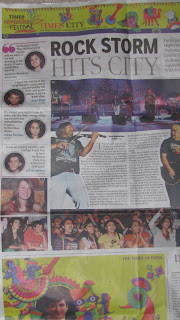Being an Indian, it might be the hardest thing to study India with a beedy eye.
Today, I am going to tell you about something as mundane (or as exotic) as my diwali.
Every year, on Diwali, my parents, who are not particularly or at all religious, say a lot of prayers in the morning.
Later, we drive all the way to my father's office (which is a good 20
kilometres south from where we live) to do the prayers over
there.
We have lunch outside, maybe somewhere expensive, come back home, and
in the evening, we go to my grandparents place, which is in the
north of Mumbai (another 20 kilometres north of where we stay) and have dinner with
them, and sometimes even say more prayers with them.
In total, we travel about 80 kilometres within the same city to:
1. Fulfill a bunch of rituals that make little sense.
2. Eat a tonne of sweets.
3. Have an expensive lunch in-between at maybe a 5 star restaurant.
4. Meet my grandparents. (And get diwali money! - most elders just hand out notes of hundreds all day)
5. Perform rituals/ prayers to a certain "Laxmi mata" who is basically the goddess of money
6. Eat a rich, traditional dinner.
I don't know if that's how
all other Indians celebrate their diwali. Clearly they don't. But for me, that is how it goes.
General things to note about diwali:
1."Saying
prayers" is a loose term. It would be more accurate to say that we
stand in front of a couple of miniature idols with flower petals thrown
all around them and then we make a fire on a plate and chant a
monotonous chant with a repetitive tune that gets stuck in one'es head, and makes absolutely no sense
to anyone's living memory about the greatness of Lakshmi.
2.
Wearing appropriate clothes can mean anything from wearing "new"
clothes on diwali to wearing a salwar kameez or even a saree. This
diwali, the fact that I wore a saree in order to follow a more tradition
path, made me stand out quite a lot and subsequently a lot of my
relatives thought I was either (a) married, (b) going to be married
soon, or (c) fantastically into Indian culture and hence not so
"Westernised".
3. On diwali, we do lakshmi pooja. Lakshmi is
the goddess of money and abundance. So basically we are praying to money
and praying for our own prosperity, which is quite far from selfless. Interestingly, my family
bought a new car this diwali, and like all Indians, thought to pray to the
car after we bought it on the day of Dhanteras. I still do not understand why Indians do this. In addition to cars, we pray to new houses and sometimes even family desktops when they're newly bought.
4.
Overall, I noticed that this year is that advertising has finally bought
over diwali, and, like Christmas, it reigns over all sorts of
hoardings, radio shows and TV ads more than ever before. In Ahmedabad, one sees a particular ad ubitquitously that says "LOSE YOUR BELLY BEFORE DIWALI". It's been there since the end of September, when I arrived in Ahmedabad.
5.
It must be said that sometimes the express purpose of celebrating
diwali, or any Indian festival, gets a bit lost in the number of rituals
and other demands it makes of us. The bursting of firecrackers,
although a comparatively recent addition than diyas to the rituals of
diwali, do more harm than good. Besides, I now know of electric diyas.
Overall, diwali gets a bit more uneco-friendly every year and that
concerns me.
6. In spite of all this, I stills see
diwali as a way to take a break from all our lives and spend some time
getting to know family. If only there were ways to make the experience
more authentic, the connection with people deeper and the spirit of help
or togetherness more conscious, there would be a lot more validity to
what we do.
As my ending note I'd like to say that I'm
interested in "designing" a culture or a thought-process/ attitude
around diwali (such as is often enough propagated by the ads and
hoardings) that convey a spirit of awareness, helping and consciousness.
When you team this with family and the annual vacation, it could to
wonders to Indian people and the Indian tussle between Western and
Internal identity as a whole. Thoughts?

















